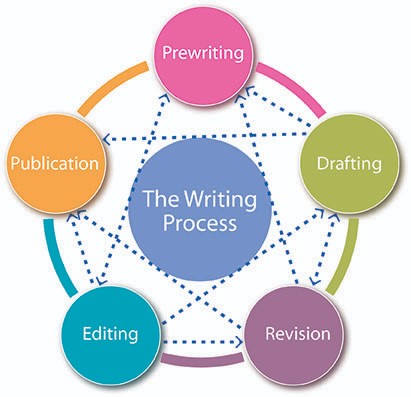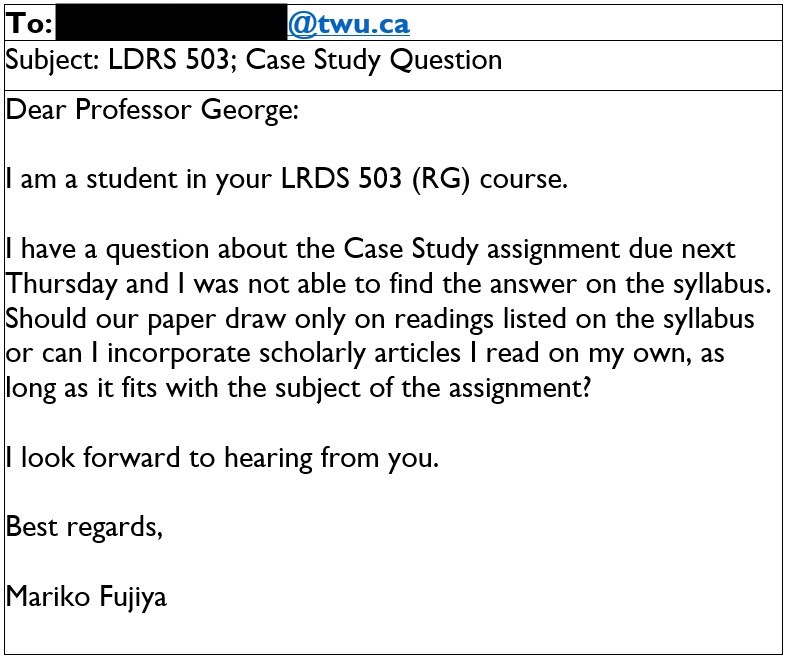Unit 1 Introduction to the Writing Centre
Created by Emily Keery
Overview
Welcome to SKLS 500! In this first unit, we will provide you with a general introduction to the Writing Centre and the philosophical foundations of research on scholarly writing, particularly the writing process. You will consider your own writing strengths and weaknesses as well as learn how to access all the services available in your time as a graduate student. You will be guided on best practices for communicating with staff and faculty that will carry over to your professional life.
Topics
This unit is divided into the following topics:
- Orientation to the Writing Centre
- The Writing Process
- Communicating with Professors
Learning Outcomes
When you have completed this unit, you should be able to:
- Identify the writing support services for different needs
- Book appointments with the Writing Centre to address specific needs
- Create a representation of your own writing process, including the different stages of writing processes.
- Write a sample message to a professor or colleague.
Activity Checklist
The learning activities in this course are ungraded, unless specified. They are designed to help you succeed in your assessments in this course, so you are strongly encouraged to complete them.
Unit 1 Learning Activities
Click here for a checklist of learning activities you will benefit from in completing this unit. You may find it useful for planning your work.
Activity 1.1: 📗 Follow the steps to register your Learning
Commons Booking Account
Activity 1.2: 📗 Journal about your best writing
environments
Activity 1.3: 🎦 Watch some videos and practice brainstorming
and outlining
Activity 1.4: 🎦 Watch some videos and reflect on drafting
strategies
Activity 1.5: 🔍 Explore the Revision and Editing Checklist,
and reflect on how to use these strategies
Activity 1.6: 📧 Practice learning activities on emailing
professors
Topic 1: What is the Writing Centre?
The Writing Centre assists all students with their academic writing assignments in any subject at any stage of the writing process. Our trained writing tutors can help you with your writing tasks such as choosing a topic, formulating a thesis, generating ideas, organizing an outline, assessing paragraph development, documenting sources, and revising sentence structure, grammar, word choice, and punctuation.
You can get help on all types of writing assignments – even non-traditional ones like blog posts, PPT slides,
We will not edit or proofread for you, but we will help you do that yourself.
We also encourage you to come more than once. Writing Centre research consistently shows improvement in student writing after three sessions. For three consecutive semesters, TWU conducted a study of first-year English and Writing classes. Students who attended the Writing Centre averaged one letter grade higher than those who did not attend. In Fall 2018, the average GPA for first-year students who used the Writing Centre was two letter grades higher than first-year students who did not.
The first visit may require some bravery: to admit some confusion, to embrace some new way of knowing, or to re-consider a part of your paper. The Writing Tutor will seek to provide a safe, motivating environment.
We look forward to working with you!
Watch the following videos on TWU’s Writing Centre.
Writing Center promo SKLS 500
null
1.0.1 Activity: Register your Learning Commons Booking Account
Follow the steps at:
-
Quick Start Guide: Register an Account
-
Log in via the Booking System
-
Fill out the registration form. (Remember all emails will go to your
mytwu.ca address. If you will not check it regularly, please forward it
to your personal account. (see instructions on how to forward emails
- Now, you can book your first appointment!
ADDITIONAL RESOURCES
Here are some helpful resources on the Writing Centre and all its services:
-
TWU
Writing Centre
- Appointment booking help pages:
-
Join a Waitlist
- Forwarding your MyTWU email address
Note that the learning activities in this course are ungraded, unless specified. They are designed to help you succeed in your assessments in this course, so you are strongly encouraged to complete them.
Topic 2: The Writing Process
Research shows that writing is a process. However, it is not an easy or linear process—it is a recursive or iterative process. It goes in circles moving forward and backward between the different stages.

Figure 1. A non-linear writing process by Oxford Centre for Staff and Learning Development. CC BY-NC-SA 2.0
It is important to learn your own process. You should consider what works for you and how long each stage might take for different writing projects.
Tips on the Writing Process
- Writing is revision. Be prepared for multiple drafts.
- Writing takes TIME.
- Writing is for readers. It is important to have others read and provide feedback. (The Writing Centre is here for you.)
Writing Environment
The physical space you do your writing matters. If you experience writer’s block, you may want to change up your space or the time of day you are writing.

1.0.2 Activity: Consider your Writing Environment
Most writers have a set “writing place.”
-
Where do you work best?
-
What time of day do you concentrate best?
- Are there different stages of the writing process that you can do in different places?
Jot down your ideas in your notes. These ideas can inform your entry in your Learning Log.
Stage 1: Prewriting
Prewriting: Understanding the Essay Prompt
Before you write it is important to know the specifics of the assignment. An essay can be well-structured and grammatically correct, but it must respond to the assignment instructions for you to succeed on the task.
Strategies for understanding the assignment
- Audience and
- Context
- Look for the key words, particularly verbs
- Look for the specifics of the parameters, format, argument, research required, etc. Consider information external to the assignment:
- Is there a rubric? Did the professor talk about it in class? Is it on the syllabus?
- Ask questions of the instructor.
- Is there a rubric? Did the professor talk about it in class? Is it on the syllabus?
- Look for the key words, particularly verbs
(Adapted from The Oxford Guide for Writing Tutors 71)
Pre-Writing: Brainstorming
A lot of the work of writing happens before you put anything down on paper. These pre-writing stages include identifying the topic, researching, and focusing your ideas.
- Talk with a friend or classmate
- Use sticky notes
- List
- Questioning (5Ws, H)
- Concept mapping (try popplet.com)
- Freewrite: write whatever comes to mind for a set amount of time
- Draw out your ideas or write in different colours
Pre-Writing: Survey the Literature
- In other words: Read about your topic.
- To have a good idea of profitable areas of research, you’ll need to have read a little about the topic as a whole.
- This step is all about gaining a general overview of the topic. To do this, you should make use of books, book chapters, journal articles, websites, and any other sources.
- This step will help you to decide on a focus and may uncover sources that you can read more deeply later on.
Pre-Writing: Choose a Focus
- Even if you already have a topic, you still need a specific focus or argument – in your paper, this will be the thesis statement.
- Pick a strong, narrow thesis statement that you can argue for, and make sure there is evidence or data to support it.
- There should be one thesis statement in the introduction of your paper. The rest of your paper is to prove or explain what you wrote in your thesis statement.
Five principles for writing a powerful, focused thesis statement:
- It fits the scope of the assignment.
- It states a single main point.
- It is specific.
- It is something you can argue or prove.
- It is forceful and written confidently.
Outlining
Writing requires organization and structure to be clear and understandable. Outlines help with organizing ideas before, during, and after drafting.
Types of Outlines
- Skeleton outline: Just include the thesis and topic sentences or point form notes.
- Full sentence outline with quotes: This allows you to have all the information in place and just put it together.
- Reverse outline: Go back and record the key ideas from each paragraph. This is a way of checking the structure.
1.0.3 Activity: Practice a Prewriting Strategy
So how do you get started on a paper? What technique do you use to brainstorm? How detailed is your outline? Choose from the following resources on prewriting techniques, and then practice with the prompt below.
Videos on Brainstorming Tips:
Brainstorming Apps:
Outline Tips
• Types of Outlines and Samples
Practice Prompt:
Use a current class assignment topic or one of the following prompts to practice a technique you’ve learned to help with the prewriting stage.
-
The reasons you chose TWU.
- Your ideal vacation.
Stage 2: Drafting
Drafting is when you start to put full sentences down on paper. It is important to not get caught up in evaluation and just let the ideas come out.
Drafting Strategies
- “Messy and Fat” Draft: Dr. Peter Elbow’s research in writing and composition showed that many writers need to free write to get ideas flowing. The goal is to just get everything down on paper and go back and edit later. This method resembles that of movie production where many scenes and versions are filmed, and the editors go through and cut things down to the final edition.
- “Hidden” Draft: Some writers fear the blank screen and blinking cursor. To help with this, one can hide the screen and not judge the amount of words recorded. Here are some possible methods: a) dim the screen, b) change the text colour to white, or c) put a picture of your happy place over the screen; then, write out all of your ideas on the screen behind it.
- Speech to Text: Talk out your ideas while recording the information in written form.MS Word and Google Docs have free versions of this technology.
1.0.4 Activity: Practice a Drafting Strategy
View one of the two following videos and consider which methods you would implement to help you in your drafting stage.
Jot down your ideas in your notes. These ideas can inform your entry in your Learning Log.
Stage 3: Revision
After the first version of an assignment, changes will ALWAYS be needed. This doesn’t mean the writer did anything wrong—it is just part of the writing process.
1.0.4.0.1 Revision Strategies
- Use a Revision Checklist
- Highlight and read just the thesis and topic sentences: The paper should make sense and have a cohesive argument.
- Cut up the paragraphs or put them on different PowerPoint slides and mix them up. Then, organize the ideas into the best order. You can go through and check the paragraph organization.
- Highlight different essay components in different colours (quotes/paraphrases, explanation/analysis/evaluation) and check the balance of explanation for your quotes/evidence.
Stage 4: Editing
The lines between revision and editing can often blur. Technically, revision is re-seeing the ideas and structure of the writing and editing is changing the sentence-level details of the writing. This is the time to correct specifics and syntax and grammar.
Editing Strategies
- Read the paper backwards: Start with the last sentence and go through the paper sentence by sentence checking for edits. This will isolate the text so one can focus on each sentence and not be distracted by whole parts together.
- Look for specific writing/grammar issues: Go through one at a time for specific things (e. g. check all subjects and verbs for agreement).
- Check the required format and citation style (APA, MLA, Turabian, etc.)
1.0.5 Activity: Revision and Editing Checklist
Review the Revision and Editing Checklist; take notes or
discuss with a partner about the following: - What items on the lists do
you always do when writing a paper?
- Which ones have you never tried?
- What topics or tasks do you struggle with the most from the lists?
Stage 5: Publication
The final stage of the process is finalizing the work for publication or submission. Do one last check for proofreading and essay format. Check the method of submission (MS Word, PDF, web-publication, etc.). Always keep a saved copy of your work in case something happens with the submission.
Topic 3 : Communicating with Professors, Staff, and Colleagues
It is vital that you learn to communicate well with your professors, staff members, and colleagues. There are certain conventions that you should follow when communicating by email or other written messaging forms (e.g. MS Teams). This style of communication will also transfer to the work environment.
Before You Write
- Is this email necessary? Reasons to email your professor: Missed class, technical difficulties, specific questions about an assignment
- Can you find this information somewhere else? Check carefully.
- Places to check: Moodle Course class PPTs, documents, Zoom recording, Course learning Plan/ Syllabus
While You Write
- Be specific and concise
- Use formal tone and language (practice your professionalism), including salutation and sign off.
- Be direct in your requests, or purpose in writing
- Don’t forget your subject line – it’s important
- Closing remark – it’s always good to say “thank you… for….”, no demands here.
Email Format
- Subject line (be specific)
- Salutation (check your formality)
- Message:
- reminder of who you are can be helpful (name/student number), what class you are in
- purpose for your email – be direct, but keep it short (1- 2 sentences here)
- reasons (briefly explain if necessary)
- reminder of who you are can be helpful (name/student number), what class you are in
- Closing remark (respectful tone)
- Sign off and your name

Here are some more tips for writing emails:
And, Sample Writing
Additional Resources
Emailing a Professor. (2020). Purdue University. Retrieved June 22, 2022
Communicating Through Email from Ecampus Ontario.
Parts of an Email from Ecampus Ontario.
Unit 1 Summary
In this first unit, you have had the opportunity to learn about the resources offered through the Writing Centre to support you at all stages of your writing process and in all writing assignments. You have deepened your understanding of your own writing process. Finally, you have learned about the expected writing conventions when messaging professors, staff, and colleagues.
Assessment
Diagnostic Writing Activity
In your first class session, you will do an in-class timed writing activity which will be a helpful diagnostic for trends in your writing.
Checking your Learning
Before you move on to the next unit, you may want to check that you are able to:
-
Identify the writing support services for different needs
-
Book appointments with the Writing Centre to address specific needs
-
Create a representation of your own writing process, including the different stages of writing processes.
-
Write a sample message to a professor or colleague.